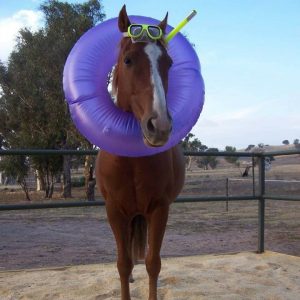
Summertime is here and the horses are feeling it! Unless your equines are very fancy, they don’t have access to A/C and ice-cold beverages, so how can you make them as comfortable as possible? Here at METS, putting horses first is our top priority and we compiled a list of the top 7 warm-weather best practices along with our favorite vet Dr. Peter Radue, DVM of Damascus Equine Associates. Stay cool and if you can, donate to our COVID-19 Relief Fund to help compromised horses.
- Remember the 150 rule! If the temperature + the relative humidity are higher than 150, it is not safe to exercise your horse because she’s unable to adequately cool herself. So, if the temperature is 90 degrees and relative humidity is 80% → 90+80=170 TOO HOT. However, 100 degrees with relative humidity at 30% → 100+30=130 is manageable.
Air temperature (F) + Relative humidity (%)
Horse cooling efficiency Less than 130
Most effective
130-150
Decreased
Greater than 150
Greatly reduced
Greater than 180 Condition can be fatal if the horse is stressed
- Algae is the enemy! During the warmer months, toxic blue algae grows predominantly in stagnant water sources like water tanks, ponds and slow streams. Other forms of bacteria and algae can grow in a water bucket as well that can deter your horse’s interest in water.
- Increase hydration! Make sure that your horses have consistent access to clean and cool water. Your horse can lose up to 2 gallons of water an hour sweating during exercise and keeping your horse interested in water is essential. Making sure water is plentiful, cool and in a shady spot and offering a salt block are all ways to make it more appealing. You can also add electrolytes to water, but make sure there is an alternative water source in the event that your horse doesn’t like the taste.
- Sweat is good! You’ve probably noticed your 4-legged pal gets extra sweaty when it’s hot out and that is totally natural. Horses regulate their temperature through sweating; as the sweat evaporates, it creates a cooling effect, so we actually want them to sweat! You can even create the evaporation effect by hosing your equine down and scraping excess water, so as the day heats up the water cools them off. If you don’t scrape, the water can actually work as insulation, making your horse hotter, so don’t forget to scrape.
- Give shade! Make sure your horse has access to shade throughout the day. Depending on the weather, you may even consider night turnout for horses that may sunburn (light greys and horses with white markings, especially).
- Create a wind tunnel! Horses love a good fan during a hot day. Some horses have been known to lean up against the fan because they love the cooling sensation, so make sure to secure a fan safely away from your curious horse’s prying lips.
- Know the warning signs of heat stroke:
- Lethargy
- Restlessness
- Increased sweating
- Fast, thready or erratic heartbeat
- Heavy breathing
- Increased salivation
- Increased body temperature
In the event of heat stroke, be sure you have your vet’s info on hand and use the following steps to cool your horse:
- Spray (with a steady stream of water) the horse’s head, back, neck, rump and legs with cool water.
- Spray and scrape the water off right away. Water can act as insulation and increase the horse’s body temperature if you don’t remove it.
- Repeat this continuously until the horse is cool, focusing on areas with the most blood flow like head, neck, back and ribs.
- Avoid any blankets, even coolers as these will just stop evaporation from happening.
- Take a rectal temperature. Even in hot weather it should be below 101 ℉.
- Watch for anhydrosis (loss of the ability to sweat). The cause is unknown although it may involve exhaustion of the sweating mechanism by prolonged exposure to heat and treatments are not always effective. Creating artificial sweat with a hose is the best palliative measure for relief.
How do you know you’re on the right track? You’ll be able to tell pretty easily. A few tests to have in your back pocket are the hydration skin pinch test and capillary refill test for easy hydration check-ins you can do in a few seconds. Appetite, consistent drinking and, as always, happy poops.
Enjoy your summer and if you can, donate to our COVID-19 Relief Fund to help horses who are in unstable situations.
Peter Radue DVM graduated from University of Georgia 1978, 1978-1979 Surgery Diploma University of Guelph, Ontario Equine practice Central Maryland 1979- present with Damascus Equine Associates. He is also a member of the Advisory board for METS, and Vice President Maryland Fund for Horses.

